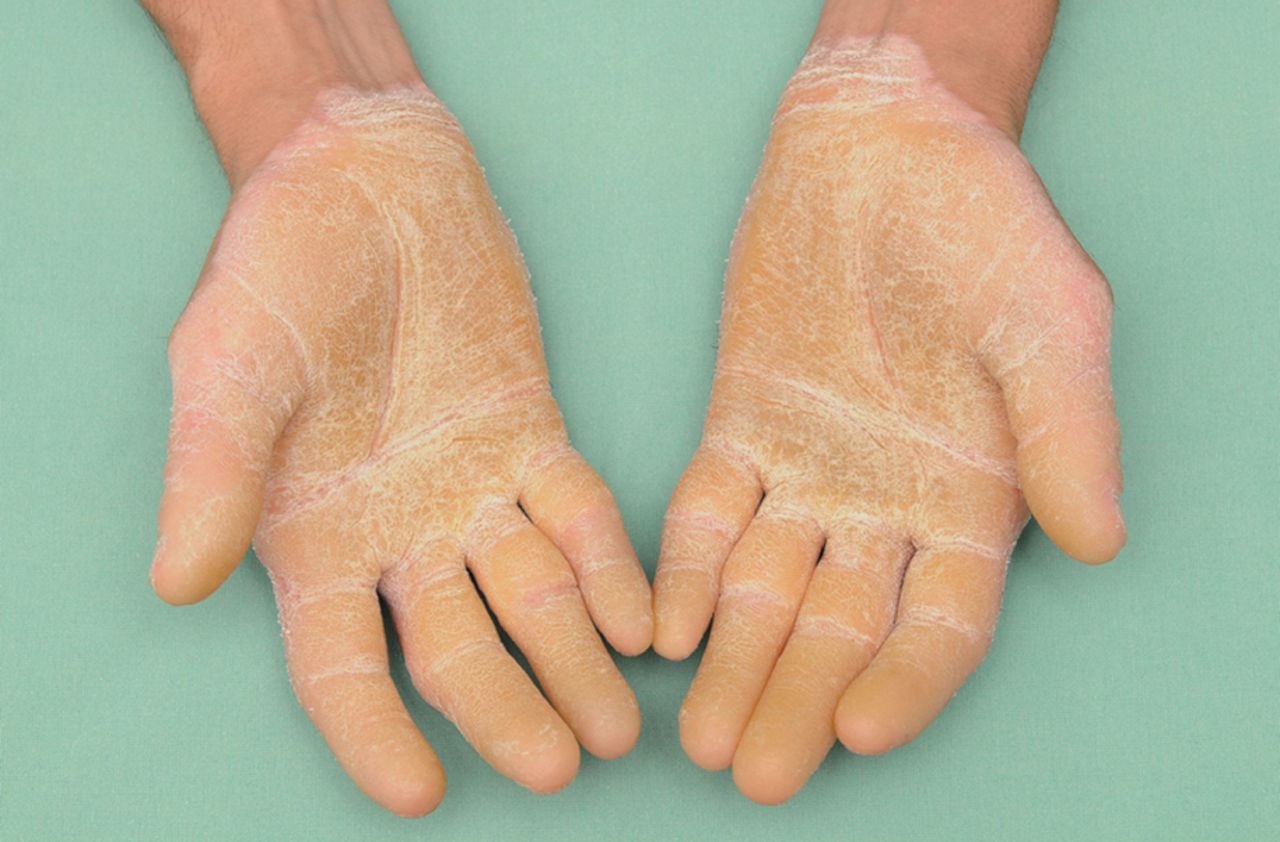
Diffuse Palmoplantar Keratoderma is a mouthful, but what exactly is it? It's a skin condition that causes thickening of the skin on the palms and soles. Imagine having calluses that never go away. This condition can make everyday tasks like walking or holding objects uncomfortable. Why does this happen? It’s often genetic, meaning it runs in families. Sometimes, it can be linked to other health issues. How common is it? Not very, but those who have it know it can be a real challenge. Want to know more? Keep reading to uncover 40 facts about this intriguing condition.
Key Takeaways:
- Diffuse Palmoplantar Keratoderma (PPK) causes thick, hard skin on the palms and soles, making daily tasks challenging. It can be inherited or acquired, and early diagnosis is crucial for effective management.
- PPK can be triggered by genetic mutations, environmental factors, systemic diseases, and infections. Regular skin care, genetic testing, and seeking support are essential for managing this condition effectively.
What is Diffuse Palmoplantar Keratoderma?
Diffuse Palmoplantar Keratoderma (PPK) is a skin condition that causes thickening of the skin on the palms and soles. This condition can be inherited or acquired and often leads to discomfort and difficulty in daily activities.
-
PPK is characterized by thick, hard skin on the palms and soles. This thickening can make it difficult to perform tasks that require fine motor skills or prolonged standing.
-
The condition can be inherited or acquired. Genetic mutations often cause inherited PPK, while acquired PPK can result from various factors like infections or systemic diseases.
-
PPK is more common in certain populations. Some ethnic groups have a higher prevalence of this condition due to genetic factors.
-
Symptoms usually appear in childhood or adolescence. Early signs include thickening and hardening of the skin on the palms and soles.
Causes and Risk Factors
Understanding the causes and risk factors associated with PPK can help in early diagnosis and management. Here are some key points to consider:
-
Genetic mutations are a primary cause. Mutations in specific genes like KRT1 and KRT9 are often responsible for inherited forms of PPK.
-
Environmental factors can trigger acquired PPK. Prolonged exposure to certain chemicals or physical trauma can lead to the development of this condition.
-
Systemic diseases can also cause PPK. Conditions like psoriasis, eczema, and certain cancers are known to be associated with acquired PPK.
-
Infections can be a risk factor. Fungal infections, in particular, can lead to the development of PPK.
Symptoms and Diagnosis
Recognizing the symptoms and understanding the diagnostic process is crucial for effective management. Here are some important facts:
-
Thickened skin is the most common symptom. The skin on the palms and soles becomes unusually thick and hard.
-
Pain and discomfort are common. The thickened skin can crack, leading to pain and discomfort, especially when walking or using the hands.
-
Itching and redness may occur. Some individuals experience itching and redness in the affected areas.
-
Diagnosis is usually clinical. Dermatologists often diagnose PPK based on the appearance of the skin and patient history.
Treatment Options
Various treatment options are available to manage the symptoms and improve the quality of life for those affected by PPK. Here are some effective treatments:
-
Topical treatments are commonly used. Creams and ointments containing salicylic acid or urea can help soften the thickened skin.
-
Oral medications may be prescribed. In severe cases, oral retinoids can be effective in reducing skin thickening.
-
Moisturizers are essential. Regular use of moisturizers can help keep the skin soft and prevent cracking.
-
Physical therapy can be beneficial. Exercises and stretches can help maintain mobility and reduce discomfort.
Living with PPK
Living with PPK can be challenging, but there are ways to manage the condition effectively. Here are some tips for daily life:
-
Wear comfortable shoes. Proper footwear can help reduce discomfort and prevent further damage to the soles.
-
Avoid harsh chemicals. Exposure to harsh chemicals can worsen the condition, so it's important to use gentle, skin-friendly products.
-
Keep the skin hydrated. Regular moisturizing is crucial to prevent cracking and maintain skin health.
-
Seek support. Joining support groups or talking to others with PPK can provide emotional support and practical advice.
Interesting Facts
Here are some lesser-known but interesting facts about PPK:
-
PPK can affect both men and women equally. There is no gender predisposition for this condition.
-
Some forms of PPK are associated with other health issues. For example, certain genetic forms of PPK can be linked to hearing loss or heart problems.
-
PPK can vary in severity. Some individuals may have mild symptoms, while others experience severe thickening and discomfort.
-
Regular check-ups are important. Regular visits to a dermatologist can help monitor the condition and adjust treatment as needed.
Genetic Aspects
The genetic aspects of PPK are fascinating and complex. Here are some key points:
-
Mutations in keratin genes are common. Keratin genes like KRT1 and KRT9 are often implicated in inherited forms of PPK.
-
Genetic testing can confirm the diagnosis. In some cases, genetic testing can help identify the specific mutation responsible for the condition.
-
Family history is important. Knowing your family history can help in early diagnosis and management of inherited PPK.
-
Genetic counseling can be helpful. For families with a history of PPK, genetic counseling can provide valuable information and support.
Research and Future Directions
Ongoing research is crucial for understanding PPK better and developing new treatments. Here are some exciting developments:
-
New genetic discoveries are being made. Researchers continue to identify new genetic mutations associated with PPK.
-
Innovative treatments are being explored. New topical and oral treatments are being tested to improve the management of PPK.
-
Stem cell research holds promise. Stem cell therapy is being investigated as a potential treatment for severe cases of PPK.
-
Patient registries are being established. These registries help researchers collect data and improve understanding of the condition.
Impact on Quality of Life
PPK can significantly impact the quality of life, but there are ways to manage and improve it. Here are some insights:
-
Daily activities can be challenging. Tasks that require fine motor skills or prolonged standing can be difficult for those with PPK.
-
Emotional well-being is affected. The visible nature of the condition can lead to self-consciousness and emotional distress.
-
Support systems are crucial. Having a strong support system can help individuals cope with the challenges of living with PPK.
-
Education and awareness are important. Educating others about PPK can help reduce stigma and improve understanding.
Prevention and Management
While PPK cannot always be prevented, there are ways to manage and reduce its impact. Here are some strategies:
-
Early diagnosis is key. Early recognition and treatment can help manage symptoms and prevent complications.
-
Regular skin care is essential. Maintaining a consistent skin care routine can help keep the skin healthy and reduce symptoms.
-
Avoiding triggers can help. Identifying and avoiding factors that worsen the condition can be beneficial.
-
Working with healthcare professionals is important. Regular consultations with dermatologists and other healthcare providers can help manage the condition effectively.
Final Thoughts on Diffuse Palmoplantar Keratoderma
Diffuse Palmoplantar Keratoderma (DPPK) is a rare skin condition that affects the palms and soles, causing thickened, calloused skin. Understanding its genetic roots helps in managing symptoms and improving quality of life. Treatments range from topical creams to more advanced therapies, aiming to reduce discomfort and enhance mobility. Early diagnosis and consistent care are crucial for managing this condition effectively. While DPPK can be challenging, staying informed and proactive makes a significant difference. If you or someone you know shows symptoms, consult a dermatologist for proper guidance. Remember, knowledge is power in dealing with any health issue. Stay curious, stay informed, and take control of your health journey.
Frequently Asked Questions
Was this page helpful?
Our commitment to delivering trustworthy and engaging content is at the heart of what we do. Each fact on our site is contributed by real users like you, bringing a wealth of diverse insights and information. To ensure the highest standards of accuracy and reliability, our dedicated editors meticulously review each submission. This process guarantees that the facts we share are not only fascinating but also credible. Trust in our commitment to quality and authenticity as you explore and learn with us.


